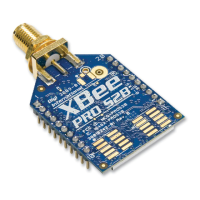XBee/XBee-PRO ZigBee RF Modules User Guide 181
Definitions
ZigBee Node Types
Coordinator A node that has the unique function of forming a network. The coordinator is responsible for
establishing the operating channel and PAN ID for an entire network. Once established, the
coordinator can form a network by allowing routers and end devices to join to it. Once the network
is formed, the coordinator functions like a router (it can participate in routing packets and be a
source or destination for data packets).
-- One coordinator per PAN
-- Establishes/Organizes PAN
-- Can route data packets to/from other nodes
-- Can be a data packet source and destination
-- Mains-powered
Refer to Coordinator operation on page 38 for more information.
Router A node that creates/maintains network information and uses this information to determine the best
route for a data packet. A router must join a network before it can allow other routers and end
devices to join to it.
A router can participate in routing packets and is intended to be a mains-powered node.
-- Several routers can operate in one PAN
-- Can route data packets to/from other nodes
-- Can be a data packet source and destination
-- Mains-powered
Refer to Router operation on page 42 for more information.
End device End devices must always interact with their parent to receive or transmit data. See the joining
definition. They are intended to sleep periodically and therefore have no routing capacity.
An end device can be a source or destination for data packets but cannot route packets. End devices
can be battery-powered and offer low-power operation.
-- Several end devices can operate in one PAN
-- Can be a data packet source and destination
-- All messages are relayed through a coordinator or router
-- Lower power modes
ZigBee Protocol
PAN Personal Area Network - A data communication network that includes a coordinator and one or
more routers/end devices.

